初中英语语法介词专题讲解
- 格式:ppt
- 大小:4.89 MB
- 文档页数:49
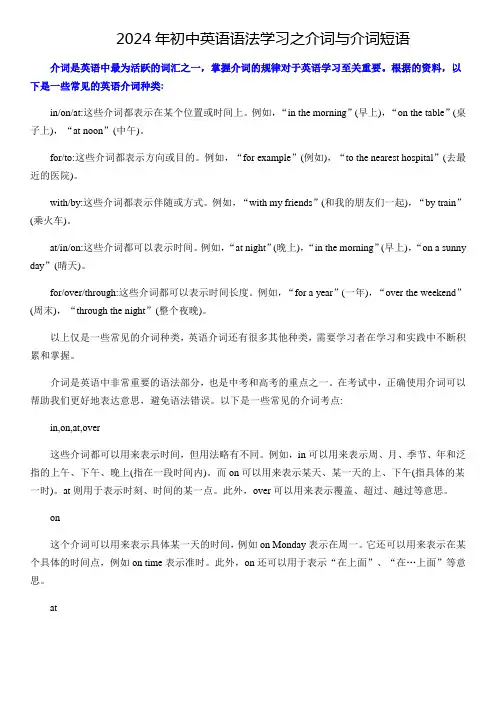
2024年初中英语语法学习之介词与介词短语介词是英语中最为活跃的词汇之一,掌握介词的规律对于英语学习至关重要。
根据的资料,以下是一些常见的英语介词种类:in/on/at:这些介词都表示在某个位置或时间上。
例如,“in the morning”(早上),“on the table”(桌子上),“at noon”(中午)。
for/to:这些介词都表示方向或目的。
例如,“for example”(例如),“to the nearest hospital”(去最近的医院)。
with/by:这些介词都表示伴随或方式。
例如,“with my friends”(和我的朋友们一起),“by train”(乘火车)。
at/in/on:这些介词都可以表示时间。
例如,“at night”(晚上),“in the morning”(早上),“on a sunny day”(晴天)。
for/over/through:这些介词都可以表示时间长度。
例如,“for a year”(一年),“over the weekend”(周末),“through the night”(整个夜晚)。
以上仅是一些常见的介词种类,英语介词还有很多其他种类,需要学习者在学习和实践中不断积累和掌握。
介词是英语中非常重要的语法部分,也是中考和高考的重点之一。
在考试中,正确使用介词可以帮助我们更好地表达意思,避免语法错误。
以下是一些常见的介词考点:in,on,at,over这些介词都可以用来表示时间,但用法略有不同。
例如,in可以用来表示周、月、季节、年和泛指的上午、下午、晚上(指在一段时间内)。
而on可以用来表示某天、某一天的上、下午(指具体的某一时)。
at则用于表示时刻、时间的某一点。
此外,over可以用来表示覆盖、超过、越过等意思。
on这个介词可以用来表示具体某一天的时间,例如on Monday表示在周一。
它还可以用来表示在某个具体的时间点,例如on time表示准时。
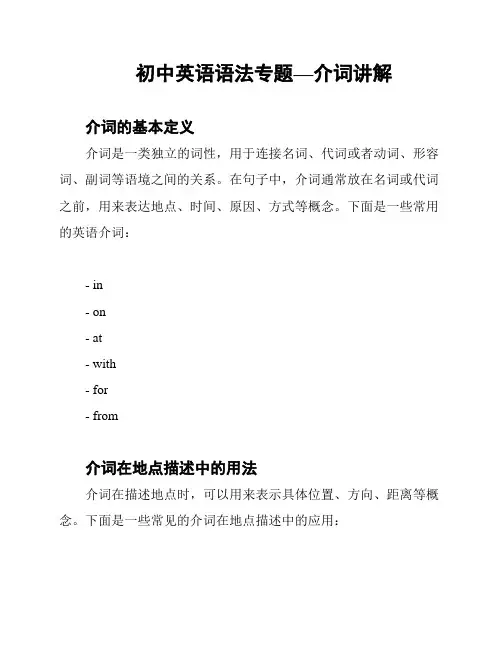
初中英语语法专题—介词讲解介词的基本定义介词是一类独立的词性,用于连接名词、代词或者动词、形容词、副词等语境之间的关系。
在句子中,介词通常放在名词或代词之前,用来表达地点、时间、原因、方式等概念。
下面是一些常用的英语介词:- in- on- at- with- for- from介词在地点描述中的用法介词在描述地点时,可以用来表示具体位置、方向、距离等概念。
下面是一些常见的介词在地点描述中的应用:- in:用于表示在某个范围之内的位置,例如 "in the room"(在房间里),"in the park"(在公园里)。
- on:用于表示在表面、平台或者位置上的状态,例如 "on the table"(在桌子上),"on the bus"(在公交车上)。
- at:用于表示在某个具体位置或者地点,例如 "at the cinema"(在电影院),"at school"(在学校)。
- to:用于表示朝向某个位置的移动,例如 "go to the park"(去公园)。
介词在时间描述中的用法介词在描述时间时,可以用来表示具体时间、时间段等概念。
下面是一些常见的介词在时间描述中的应用:- at:用于表示具体的时间点,例如 "at 7 o'clock"(在7点钟)。
- on:用于表示具体的日期或者星期几,例如 "on Monday"(星期一),"on January 1st"(1月1日)。
- in:用于表示较长的时间段或者某一个时间段内,例如 "inthe morning"(早上),"in July"(在七月)。
介词在原因描述中的用法介词在描述原因时,可以用来表示某事的起因或者原因。
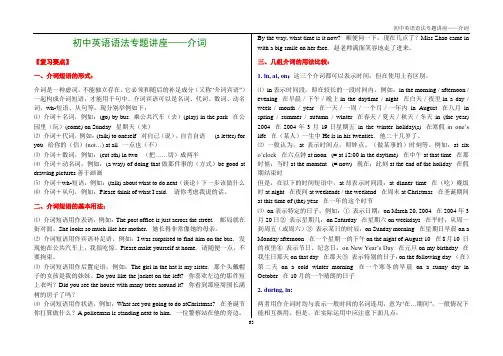
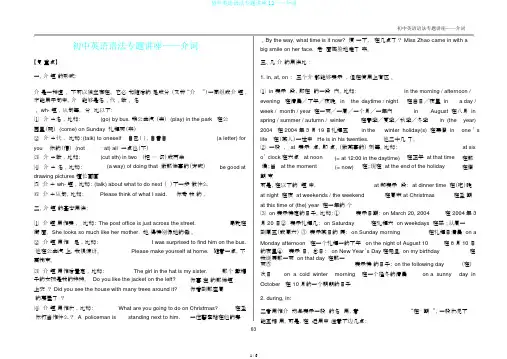
初中英语语法专题讲座——介词【复重点】一、介短的形式:介是一种虚,不可以独立存在。
它必和随后的足成分(又称“介”)一同组成介短,才能用于句中。
介能够是名、代、数、名、 wh- 短、从句等。
分比以下:⑴介+名,比如:(go) by bus 乘公共汽(去) (play) in the park 在公园里(玩) (come) on Sunday 礼拜天(来)⑵介+代,比如:(talk) to oneself 自己(),自言自(a letter) for you你的(信) (not⋯ at) all 一点也(不)⑶介+数,比如:(cut sth) in two (把⋯⋯切)成两半⑷介+名,比如:(a way) of doing that 做那件事的(方式)be good at drawing pictures 擅长画画⑸介+ wh- 短,比如: (talk) about what to do next ()下一步做什么⑹介+从句,比如:Please think of what I said.你考我的。
二、介短的基本用法:⑴介短用作表,比如: The post office is just across the street.局就在街面。
She looks so much like her mother. 她得特别像她的母。
⑵ 介短用作足,比如:I was surprised to find him on the bus.他在公共汽上,我很惊讶。
Please make yourself at home. 随意一点,不要拘束。
⑶ 介短用作后置定,比如:The girl in the hat is my sister.那个戴帽子的女孩是我的妹妹。
Do you like the jacket on the left?你喜左的那件短上衣? Did you see the house with many trees around it?你看到那座周的房屋了?⑷ 介短用作状,比如:What are you going to do on Christmas?在圣你打当作什么? A policeman is standing next to him.一位警察站在他的旁初中英语语法专题讲座——介词。

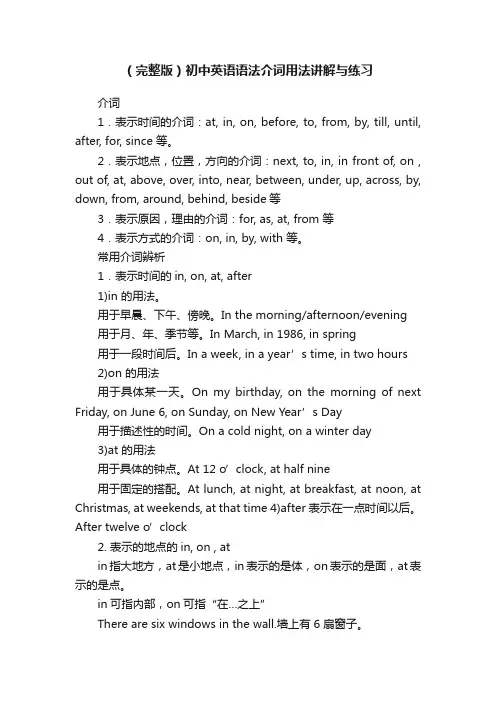
(完整版)初中英语语法介词用法讲解与练习介词1.表示时间的介词:at, in, on, before, to, from, by, till, until, after, for, since 等。
2.表示地点,位置,方向的介词:next, to, in, in front of, on , out of, at, above, over, into, near, between, under, up, across, by, down, from, around, behind, beside等3.表示原因,理由的介词:for, as, at, from 等4.表示方式的介词:on, in, by, with 等。
常用介词辨析1.表示时间的in, on, at, after1)in 的用法。
用于早晨、下午、傍晚。
In the morning/afternoon/evening用于月、年、季节等。
In March, in 1986, in spring用于一段时间后。
In a week, in a year’s time, in two hours2)on 的用法用于具体某一天。
On my birthday, on the morning of next Friday, on June 6, on Sunday, on New Year’s Day用于描述性的时间。
On a cold night, on a winter day3)at 的用法用于具体的钟点。
At 12 o’clock, at half nine用于固定的搭配。
At lunch, at night, at breakfast, at noon, at Christmas, at weekends, at that time 4)after 表示在一点时间以后。
After twelve o’clock2. 表示的地点的in, on , atin指大地方,at是小地点,in表示的是体,on表示的是面,at表示的是点。


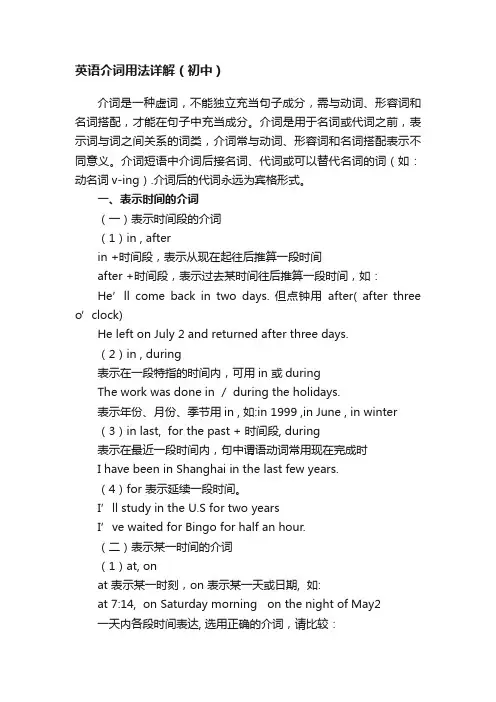
英语介词用法详解(初中)介词是一种虚词,不能独立充当句子成分,需与动词、形容词和名词搭配,才能在句子中充当成分。
介词是用于名词或代词之前,表示词与词之间关系的词类,介词常与动词、形容词和名词搭配表示不同意义。
介词短语中介词后接名词、代词或可以替代名词的词(如:动名词v-ing).介词后的代词永远为宾格形式。
一、表示时间的介词(一)表示时间段的介词(1)in , afterin +时间段,表示从现在起往后推算一段时间after +时间段,表示过去某时间往后推算一段时间,如:He’ll come back in two days. 但点钟用after( after three o’clock)He left on July 2 and returned after three days.(2)in , during表示在一段特指的时间内,可用in 或duringThe work was done in / during the holidays.表示年份、月份、季节用in , 如:in 1999 ,in June , in winter(3)in last, for the past + 时间段, during表示在最近一段时间内,句中谓语动词常用现在完成时I have been in Shanghai in the last few years.(4)for 表示延续一段时间。
I’ll study in the U.S for two yearsI’ve waited for Bingo for half an hour.(二)表示某一时间的介词(1)at, onat 表示某一时刻,on 表示某一天或日期, 如:at 7:14, on Saturday morning on the night of May2一天内各段时间表达, 选用正确的介词,请比较:in the morningon a winter / snow / cold / morningat nighton the night of March 7thin the eveningon Friday evening(2)before, bybefore 表示某一时间之前,而by 表示到某一时间止,句中谓语动词多用完成时态。
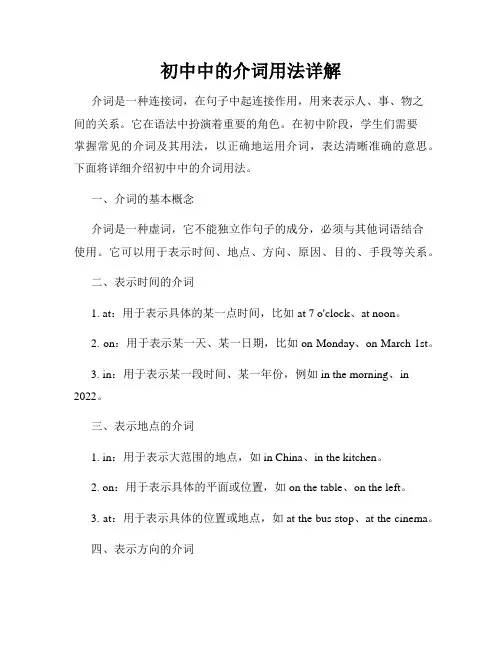
初中中的介词用法详解介词是一种连接词,在句子中起连接作用,用来表示人、事、物之间的关系。
它在语法中扮演着重要的角色。
在初中阶段,学生们需要掌握常见的介词及其用法,以正确地运用介词,表达清晰准确的意思。
下面将详细介绍初中中的介词用法。
一、介词的基本概念介词是一种虚词,它不能独立作句子的成分,必须与其他词语结合使用。
它可以用于表示时间、地点、方向、原因、目的、手段等关系。
二、表示时间的介词1. at:用于表示具体的某一点时间,比如at 7 o'clock、at noon。
2. on:用于表示某一天、某一日期,比如on Monday、on March 1st。
3. in:用于表示某一段时间、某一年份,例如in the morning、in 2022。
三、表示地点的介词1. in:用于表示大范围的地点,如in China、in the kitchen。
2. on:用于表示具体的平面或位置,如on the table、on the left。
3. at:用于表示具体的位置或地点,如at the bus stop、at the cinema。
四、表示方向的介词1. to:表示朝向某个地点或目的地,例如go to school、send the letter to her。
2. from:表示从某个地点或源头出发,例如come from Japan、receive a gift from my friend。
五、表示原因的介词1. because of:表示由于某个原因,如failed the exam because of laziness。
2. due to:表示由于某个原因产生的结果,例如missed the train due to the traffic jam。
六、表示目的或用途的介词1. for:用于表示目的或用途,例如study hard for a good future、buy flowers for my mother。
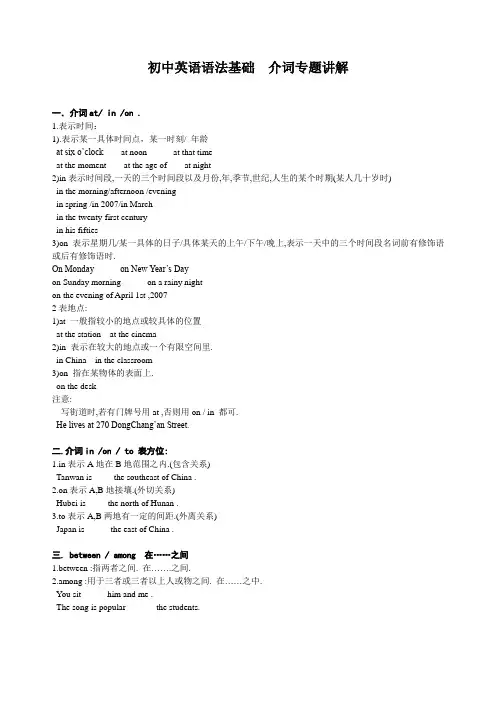
初中英语语法基础介词专题讲解一.介词at/ in /on .1.表示时间:1).表示某一具体时间点,某一时刻/ 年龄at six o’clock at noon at that timeat the moment at the age of at night2)in表示时间段,一天的三个时间段以及月份,年,季节,世纪,人生的某个时期(某人几十岁时)in the morning/afternoon /eveningin spring /in 2007/in Marchin the twenty-first centuryin his fifties3)on表示星期几/某一具体的日子/具体某天的上午/下午/晚上,表示一天中的三个时间段名词前有修饰语或后有修饰语时.On Monday on New Year’s Dayon Sunday morning on a rainy nighton the evening of April 1st ,20072表地点:1)at 一般指较小的地点或较具体的位置at the station at the cinema2)in 表示在较大的地点或一个有限空间里.in China in the classroom3)on 指在某物体的表面上.on the desk注意:写街道时,若有门牌号用at ,否则用on / in 都可.He lives at 270 DongChang’an Street.二.介词in /on / to 表方位:1.in表示A地在B地范围之内.(包含关系)Tanwan is ____ the southeast of China .2.on表示A,B地接壤.(外切关系)Hubei is ____ the north of Hunan .3.to表示A,B两地有一定的间距.(外离关系)Japan is _____ the east of China .三. between / among 在……之间1.between :指两者之间. 在…….之间.2.among :用于三者或三者以上人或物之间. 在……之中.You sit _____ him and me .The song is popular ______ the students.四.after / in 在……之后 before / in 在……之前1. after1)after + 时间段. 表示以过去某一时刻为起点的一段时间之后, 用于过去时.2)after 作介词. after doing sth.2.in +一段时间. 表示说话时或以现在为起点的将来一段时间之后.用于将来时.He came back ______ two days .He will go home___finishing his homework .He will come back _____ two days .3. before 多用于时间点或一件事之前发生,即“先于……;在……之前”He left the office bofore I got there. I’ll be back before five o’clock.4. ago 时间段+ ago 表示“多久之前”时态通常用:一般过去时I met Tom two days ago.五.with / in / by 表示“用……”1.with 表示“用…” 一般指有形的工具/ 手段/ 人体器官.He cut the apple into halves ____ a knife .注: with 表伴随, “带有,含有”He came in _____ a big smile on his face .2.in表示用某种语言,方式,途径. 或书写/绘画所用的材料. 也可表交通方式.Can you say it _____English ?He wrote a letter ____ blue ink .3.by表示乘坐交通工具, 表示方式,方法I study for a test _____ working with a group .He makes a living ____ selling newspapers .注意: 同义词组1).by phone = on the phone2).by car = in a car3).in pen = with a pen = with pens六.across / through / over / by 经过1.across 指横穿,穿过. 表示动作从某一物体表面上经过.2.through 指穿过,透过,表示从某一物体空间内通过.3.over 表示从某人或某物的上空经过或越过,不与表面接触.4.by 表示从某人/某物的旁边经过.Can you swim ______ the river ?the elephant is so big that it can’t go _____ the gate .I don’t think anyone can jump ___ the fenc e.I walked _____ the bank of China yesterday .七.in front of / in the front of1.in the front of 表示在…….内部的前面2.in front of 表示在……外面的前面There is a desk in _____ front of our classroom .There is a big tree in _____ front of our classroom.八.其它介词的用法:1.at的其它用法.1).表示“从事或正在做某事”,其后加的名词往往不加冠词.She is at work now = She is working now .2)at表示“价格或速度”The train ran at 120 kilometers an hour .2.in的其它用法:1)in表示“在……方面”词组:do well in = be good atbe weak in2)in 表示“穿着”后接表颜色的词或衣服.词组: be in +衣服= be wearing +衣服3)in作副词, “在家” = at home3.like 的用法:1).像/和……一样. 常与系动词连用.词组: look like sound like2).与what 连用, “是什么样子, 怎样”.What is he like ? He is kind .4.off的用法:1).从……下来, 脱离某物体.词组: fall off2). “休假”通常放在时间名词之后.词组: have +时间+ offHe has n’t had a night off for two hours .5.except / besides1).except 除了…….之外, 都……. . 不包括在范围之内.注: nothing but … 除了……之外,什么也没有.2).besides除了……之外,还有…… . 包括在范围之内.We all went swimming ______ Lucy .There is _______ a letter in the box .We study Japanese and French____ English .6.with / without1).with具有,含有反义词: without 没有词组: with the help of = with one’s help =because of = thanks towithout one’s help2).without 的用法:A).without + sb./ sth. 没有某人或某物B).without + doing sth . He lef t here without____(say ) “Goodbye”to usC). without sth 常与if 引导的否定的条件句.If there is no water , we can’t live .= We can’t live ______ _______ .7.on the tree /in the treeon the tree 表示“树上本身长的东西” 在树上.in the tree 表示“外界的物体进入树中” 人或物在树上.There are some apples _____ the tree .There is a boy ____ the tree.8.表示“数量的介词”about , round around , over1). about , round around表示“大约……”2).over 表示“超过”= more than.9.inside / outsideInside 在……里面------反义词:outside在….外面10.in the wall /on the wallin the wall 表示“门窗在墙上” on the wall 表示“某东西张贴或挂在墙上”九.不用介词的情况:1).当时间状语为: tonight, today, yesterday, tomorrow 等时,不用介词. What are you going to do tonight ?2).含有this, that, these, those, last, next, every/each day等时间状语.He went to Wuhan last week . I drink milk every day.3).以all 开头的时间状语前面不用介词.He has worked all day .4).以some ,any, one 等构成的时间状语前不用介词.He met a bad man one cold morning. = He met a bad man on a cold morning.介词专题小测:一、单项选择题。
初中英语语法:英语介词口诀详解在初中英语学习中,语法是一个重要的部分,而介词的运用更是让许多同学感到头疼。
不过,别担心,今天我们就来通过一些口诀详细地解读一下初中英语中的介词。
一、关于时间的介词“in 年 in 月 in 季,on 日 on 号 on 星期”,这是我们首先要记住的口诀。
比如说,“in 2023”(在 2023 年),“in May”(在五月),“in spring”(在春天);而“on Monday”(在星期一),“on June 1st”(在 6 月 1 日),“on a sunny day”(在一个晴朗的日子)。
但要注意,如果具体到某一天的上午、下午或晚上,就要用“on”。
例如,“on the morning of June 1st”(在 6 月 1 日的上午)。
“at 用于时刻前,黎明午夜和点分”。
“at six o'clock”(在六点钟),“at noon”(在中午),“at midnight”(在午夜)。
二、关于方位的介词“in 在里,on 在上,at 表示小地点”。
“in the room”(在房间里),“on the table”(在桌子上),“at the bus stop”(在公交车站)。
“between 两者之间,among 三者或以上之中”。
例如,“The ball is between the two chairs”(球在两把椅子之间。
)“He is the tallest among the students”(他是学生中最高的。
)“in front of 外部的前面,in the front of 内部的前面”。
“There is a tree in front of the house”(房子前面有一棵树。
)“The teacher i s standing in the front of the classroom”(老师站在教室的前面。
中考英语介词的用法讲解中考英语介词的用法讲解一、知识框架二、知识点梳理一、定义:介词:是一种用来表示词与词、词与句之间的关系的词,在句中不能单独作句子成分。
二、介词短语的句法作用1、介词短语相当于一个形容词或副词,可用作状语、定语和表语。
如:The man came .(状)The woman is from the countryside.(定)The teacher is now with the pupils.(表)(老师现在和学生在一起)2、介词短语在句子中的位置:介词短语做状语时,如果表示时间/地点,可以放在句首或句尾。
如果表示方向/方式/伴随/涉及/原因/目的/比较,一般放在句尾;介词短语作表语时放在连系动词之后;介词短语作定语时,只能放在被修饰的名词之后。
如:He wanted to find a good job in Shanghai the next year.(状语)They searched the room for the thief.The letters are for you.(表语)Have you seen a cat with a black head and four white legs?(定语)三、介词用法(一)表时间的介词:1.at通常用于:(表示在某个时刻或者瞬间)at+时间点,节日(泛指圣诞节、新年等整个假期时,要用at)如:at 7:30; at lunch time; at Christmas 在圣诞节期间固定词组搭配:at dawn, at night, at midnight, at noon, at that time, at the moment2. on通常用于:(表示在具体的某一天或者某天的上下午等)on+具体时间(日期,星期几)on October 1st ; on Monday; on a rainy morning; on Teachers’ Dayon Christmas Day 在圣诞节这一天3. in通常用于:(表示在一段时间里)①in+世纪/年/月/季节/早/中/晚in the 20th century, in the late 18th century②特定的年龄段,in his thirties (在他30多岁时)补充1:表示“在一段时间之后”,句子常用一般将来时。
【中考英语语法汇总】介词语法讲解(一)介词概述介词是一种虚词,在句子中不单独作任何句子成分。
它是一种表示名词和句中其他词之间关系的词。
它常和名词、动词、形容词等搭配,构成固定短语,表示不同意思。
介词还可以与名词构成介词短语,表示方位、方向、时间、地点、方式、原因等。
这些介词短语在句中可充当定语、状语、补语等。
2000—2005年的中考中主要考了形容词与介词的搭配:如:be famous for;表示时间的介词,如:at night;动词与介词的搭配,如:arrive in/have dinner with sb.;表示方式、手段的介词,如:by phone/in English.(二)基础知识梳理1.名词与介词的搭配a bit of有一点儿 a couple of两个、几个a kind of一种、一类 cover an area of占地面积have pity on sb.怜悯某人huge amounts of大量的make friends with与……交朋友 make fun of拿……开玩笑meet the needs of迎合……的需要 one after another一个接一个;连续地play a trick on捉弄 the week after next下下周2.动词与介词的搭配agree with sb.同意某人的意见 apologize to sb. for sth.为某事向某人道歉arrive at/in a place到达某地 ask for请求、寻求be covered with被……所覆盖 be made of由……制成be made up of由……组成 belong to属于break into破门而人、闯入 call on拜访care for照顾、喜欢 carry out执行check in办理登机 come across被理解;遇见come from出生于、来自 come on跟我来、走吧communicate with与……交cut down砍倒deal with= do with处理depend on= rely on依靠、依赖die of因……病而死dream of梦见dress up穿着、打扮 eat up= finish off吃光、喝完、吞噬enter for报名参加fall off从……跌落fill in填充、填写 find out找出、查明、了解get along/on with进展、与……相处 get in the way挡道get in进入、收集 get on上车get off下车 get rid of摆脱get ready for为….作准备 get to到达get tired of对……感到厌倦 go in for参加、从事于、酷爱,'^ go ahead先走、向前走;去吧 go for a swim去游泳go on a diet实行节食 go over复习go on with继续做某事 grow up长大、成长hand in上交 hear from收到……的来信hear of听说 help sb. with sth.帮助某人做某事hold on等等(别挂电话)hold up举起hurry off匆忙离开join.n参加、加入keep... from使……不做 keep in touch with与……保持联系keep off阻挡;不让接近 knock over撞倒、撞翻later on过来;后来 laugh at嘲笑learn.., from向……学习 leave for动身去let out放出 line up整队;排成行live on靠……为生look after照顾;照料look at看;观看 look for寻找look forward to期待着 look like看上去像;显得look out of从……朝外看look up查寻;抬头看make out辨认出make up one's mind下决心meet with遭遇 operate on sb.为……动手术pay for付……钱 pick out拾起play with玩弄point at指向;指着point out指出praise sb. for sth.为某事表扬某人prefer... to(比起……来)更喜欢 prepare for准备protect... from保护……免受 pull down推倒put off延期put on穿;戴上;上演put out伸出 put up举起;挂起run after追捕;追踪 run away逃跑search for搜寻;搜查see off为……送行sell out售完 set out/off for出发去……;起程去……set up建立;设立. shake hands with与……握手share with与……分享show off炫耀show sb around带某人参观 shut up住口speed up加快速度stop...from阻止……做take away拿走 take care of照料take charge of负责;管理;take hold of抓住take in吸入 take off脱掉(衣物等);起飞take out取出take part in参加take up开始从事 talk about谈到talk to/with与...谈话 tell... from区别;分辨think of想起;想到 think over仔细考虑throw away扔掉 tie up捆绑try on 试穿turn down(把音量)调低turn into变成 turn off关掉(电灯、电视、收音机等)turn on开,旋开(电灯、电视、收音机等) turn over翻车;翻阅;翻身turn out结果是;证明是 wake up醒来;叫醒wait for等待;等候 write down写下work out算出;制定出经典例题:1.The foreigners arrived __________Shanghai __________ night.A. at…atB. in…atC. in... inD. at... in2. Wushu is becoming more and more popular __________ westerners.A. amongB. betweenC. inD.within3. __________ the help of the teachers, we decorated. Ourclassroom__________lanterns, flowers and pictures yesterday.A. Under... withoutB. Under... amongC. With... withD.With...between4. The cakes __________ the shape of a round moon is called mooncakes.A. likeB. look likeC. asD. likes5.改错:The manager told his secretary that he would be back __________ three-thirty.A. inB. afterC. beforeD. at6. It was clever __________ the boy to work __________ the mathsproblems in less than ten minutes.A. for…outB. of... outC. for...onD. of... on7. My aunt Jane tried her best to reduce her weight ________ 6kg.A.about B.at C.to D.by8. In my opinion, I agree __________ you __________that.A. to… withB. with…toC. with.., withD. with.., on9. I am familiar__________ this school since I have worked here for morethan fifteen years.A. withB. toC. aboutD. of10. Would you please look __________ my baby girl __________ myabsence?A. after…duringB. for…duringC. after… inD. to...in11. Mexico is ________ the south of America.A. inB. toC. onD. of12. The boy ____ the bike is Jackie Hu from Britain.A. byB. onC. inD. with13. Smoking and drinking are not good _______ your health.A. forB. toC. ofD. at14. Can you see the cat hiding __________ the tree?A. onB. underC. overD. in15. The litter bin__________ the corner of the room is a present from mybrother.A. atB. onC. inD. among16. It's fun to see a large number of stars shining in the sky ________ aclear night.A. atB. inC. onD. of1. 【解析】答案是B。
九年级英语专题复习教案:介词和介词短语知识讲解(中考资料)第一章:介词概览1.1 教学目标让学生理解介词的基本概念和用法。
能够辨别和运用常见介词。
1.2 教学内容介词的定义和分类。
常见介词的用法和例句。
1.3 教学步骤介绍介词的概念和分类。
通过例句展示常见介词的用法。
学生练习辨别和运用介词。
第二章:介词短语2.1 教学目标让学生理解介词短语的概念和用法。
能够辨别和运用常见介词短语。
2.2 教学内容介词短语的定义和分类。
常见介词短语的用法和例句。
2.3 教学步骤介绍介词短语的概念和分类。
通过例句展示常见介词短语的用法。
学生练习辨别和运用介词短语。
第三章:介词和介词短语的辨析3.1 教学目标让学生能够辨别和正确运用介词和介词短语。
3.2 教学内容介词和介词短语的辨析方法。
常见介词和介词短语的混淆点。
3.3 教学步骤介绍介词和介词短语的辨析方法。
通过例题展示常见介词和介词短语的混淆点。
学生进行辨析练习。
第四章:介词和介词短语的运用4.1 教学目标让学生能够熟练运用介词和介词短语。
4.2 教学内容介词和介词短语的运用技巧。
常见介词和介词短语的运用场景。
4.3 教学步骤介绍介词和介词短语的运用技巧。
通过例题展示常见介词和介词短语的运用场景。
学生进行运用练习。
第五章:中考介词和介词短语题型解析5.1 教学目标让学生了解中考介词和介词短语的题型。
掌握解题技巧和方法。
5.2 教学内容中考介词和介词短语的题型分析。
解题技巧和方法。
5.3 教学步骤分析中考介词和介词短语的题型。
分享解题技巧和方法。
学生进行真题练习。
第六章:介词和介词短语的综合练习6.1 教学目标让学生通过综合练习巩固介词和介词短语的知识。
提高学生的综合运用能力。
6.2 教学内容综合练习题:包括选择题、填空题、改错题等。
6.3 教学步骤给学生发放综合练习题。
学生独立完成练习题。
老师讲解答案并指出学生常见错误。
第七章:介词和介词短语的拓展知识7.1 教学目标让学生了解介词和介词短语的拓展知识。